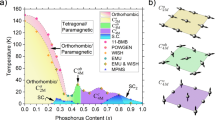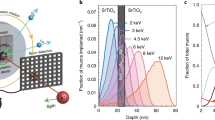Abstract
AT the heart of the controversy about the microscopic origin of superconductivity in high-transition-temperature copper oxide superconductors is the question of whether or not the antiferromagnetism associated with the single-hole Cu2+ 3d9 state is of fundamental importance. To test whether this unconventional spin-mediated superconductivity might be electron/hole symmetric, oxides of the elements with single d-orbital electrons, such as Ti3+ (3d1), Nb4+ (4d1) and W5+ (5d1), are of particular interest. Localized magnetic spin states and magnetic ordering have never been observed previously in transition-metal oxides with one or two electrons in the 4d or 5d states, because of the preference for conventional d-band metallic conductivity or for metal–metal bonding. In exploring the possibility of a dl–d9 and ferroelec-tricity-superconductivity relationship in oxides (see, for instance, ref. 1), we have found that Nb12O29, a material with a 'crystallographic shear' structure, displays simultaneously both metallic conductivity, a signature of delocalized electrons, and local-moment magnetism with an antiferromagnetic ordering temperature of 12 K. This suggests that the bonding to oxygen of the 4d levels of early-transition-metal elements may not be sufficiently covalent to yield the kind of exotic conductivity (and thus exotic superconductivity) observed for copper oxides.
This is a preview of subscription content, access via your institution
Access options
Subscribe to this journal
Receive 51 print issues and online access
$199.00 per year
only $3.90 per issue
Buy this article
- Purchase on Springer Link
- Instant access to full article PDF
Prices may be subject to local taxes which are calculated during checkout
Similar content being viewed by others
References
Muller, K. A. Phase Transitions 22, 5–7 (1990).
Roth, R. S. & Wadsley, A. D. Acta crystallogr. 19, 42–47 (1965).
Wadsley, A. D. & Andersson, S. in Perspectives in Structural Chemistry 3 (eds Dunitz, D. & Ibers, J. A.) 1–58 (Wiley, New York, 1970).
Shigeyuka Kimura J. Solid St. Chem. 6, 438–449 (1973).
Maruco, J. F. J. chem. Phys. 70, 649–654 (1979).
von Dreele, R. B. & Cheetham, A. K. Proc. R. Soc. Lond. A338, 311–326 (1974).
Norin, R. Acta chem. scand. 17, 1391–1404 (1963).
Wadsley, A. D. Acta. crystallogr. 14, 660–670 (1961).
Nozak, A., Yoshikawa, H., Wada, T., Yamauchi, H. & Tanaka, S. Phys. Rev. B43, 181–185 (1991).
Rey, M. J. et al. J. Solid St. Chem. 85, 321–324 (1990).
MacLean, D. A. & Greedan, J. E. Inorg. Chem. 20, 1025–1029 (1981).
Mott, N. F. in Metal Insulator Transitions (Taylor and Francis, New York, 1974).
Author information
Authors and Affiliations
Rights and permissions
About this article
Cite this article
Cava, R., Batlogg, B., Krajewski, J. et al. Antiferromagnetism and metallic conductivity in Nb12O29. Nature 350, 598–600 (1991). https://doi.org/10.1038/350598a0
Received:
Accepted:
Issue Date:
DOI: https://doi.org/10.1038/350598a0
Comments
By submitting a comment you agree to abide by our Terms and Community Guidelines. If you find something abusive or that does not comply with our terms or guidelines please flag it as inappropriate.



